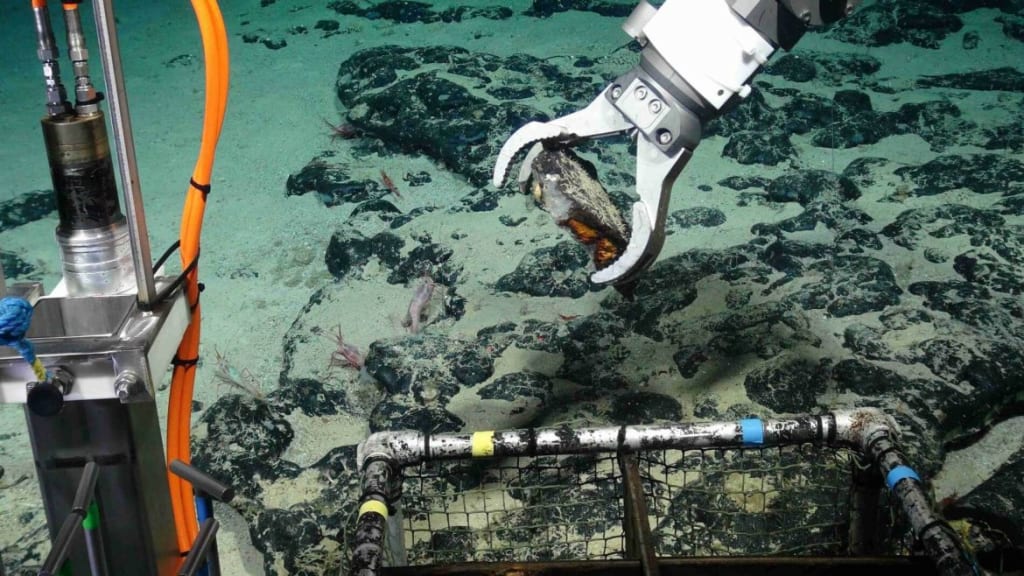What Is Happening At The Bottom of The Sea
Mining the Ocean

A ship was dispatched by a Canadian mining corporation in 2012 to investigate this isolated region of the Pacific Ocean. The Clarion-Clipperton Zone is located a few hundred miles southeast of Hawaii. A vast deposit of minerals and metals valued at billions of dollars is hidden thousands of meters below the ocean's surface. These are essential for everything. such as computers, phones, jet engines, stainless steel automobile engines, and electrical wiring. Thus far, the world's land-based mineral reserves have sufficed to meet human demands. Our needs, however, are evolving. We require clean energy to completely decarbonize. And in order to get there, we need up to six times as many metals. Estimates indicate that the Clarion-Clipperton Zone contains more of these metals.more than the total of these deposits on land. For this reason, the Canadian business is not by itself. There are currently sixteen more expedition ships, representing different nations and private businesses. they are racing towards the ocean floor. The decision of which of them is the first to mine the deep sea will be made by a little-known UN body that is now debating two important issues. Does seabed mining cause irreversible environmental harm, and is it worth it in the fight against climate change? And should a few countries benefit financially from a common natural resource. only due to the fact that they arrived first? In 1958, the UN started drafting the rules of the sea. They ultimately came to the conclusion that their sovereignty extends 12 miles offshore from a country's shoreline.Their exclusive economic zone, which is 200 miles away, is where the nation can mine, drill for oil and gas, and engage in fishing. However, a total of 72% of the deep ocean is unclaimed territory for any one nation. They just refer to it as The Area, and it has become humankind's shared legacy. That is the location of the Clarion-Clipperton Zone, which is rich in minerals. Since the British HMS Challenger sailed around the entire globe in the 1870s to survey the ocean, we have been aware of this metallic richness. Explorers reported discovering multiple unusual black oval bodies that they had pulled up from the seafloor when they were over the Pacific.These were apple-sized boulders that were rich in metals including nickel, cobalt, and manganese. Metals have been found in three distinct types of deposits on the world's seafloor by oceanographers. They are situated in what resemble submerged hot springs—hydrothermal vents. embedded in the peaks and valleys of underwater mountains. was discovered on the seafloor as rocks scattered across large, level fields. These are concentrated in the base of the Clarion-Clipperton zone, where they are most plentiful. Multinational corporations were preparing to mine the ocean floor for industrial purposes such electrical wiring, stainless steel, and fertilizer in the 1960s and 1970s after learning about these discoveries. Businesses from the US, Australia, the Soviet Union, China, and Japan,Some countries from Europe landed in the Clarion-Clipperton region. In addition to testing mining machinery, they captured some of the earliest images of the seafloor's rocks. The Maltese representative to the UN delivered a crucial address during this initial period of anarchy at sea, cautioning against replicating the errors of colonialism. According to him, the race would keep the majority of the world's resources exclusively for the advantage of a small number of countries. It would make the affluent richer and the strong stronger. "Those who support it, please click the green button." Consequently, the United Nations gathered in 1982 to draft further rules of the sea, which were signed by more than 100 nations and included three key requirements for mining in the region. No matter where it is, it must be for the good of all humankind. Take into account the unique requirements and interests of developing nations. and guarantee the preservation of the maritime ecosystem. In Kingston, Jamaica, they established the International Seabed Authority, or ISA, to enforce these new regulations. Each nation that ratified the laws of the sea would become an ISA member. That figure now stands at 168, including the European Union. Out of these, 36 nations are chosen every few years to consider applications for deepwater mining. A nation must apply through this council for an exploration contract before it is granted authorization to mine. When the council approves an application, it grants the applicant 75,000 square kilometers of deep sea. To be fair, it reserves a portion of equal value for a developing country to claim. However, other countries or businesses can gain access to this restricted area by collaborating with developing countries. That's how this ship ended up in this location in 2012. The Metals Company is based in Canada, but they sought sponsorship from the tiny Pacific Island nation of Nauru. They applied for an exploration contract together, and the company gained access to Nauru's reserved area. The Metals Company received sponsorship from two more Pacific islands, Kiribati and Tonga, in 2015 and 2020.
About the Creator
Enjoyed the story? Support the Creator.
Subscribe for free to receive all their stories in your feed. You could also pledge your support or give them a one-off tip, letting them know you appreciate their work.






Comments
There are no comments for this story
Be the first to respond and start the conversation.